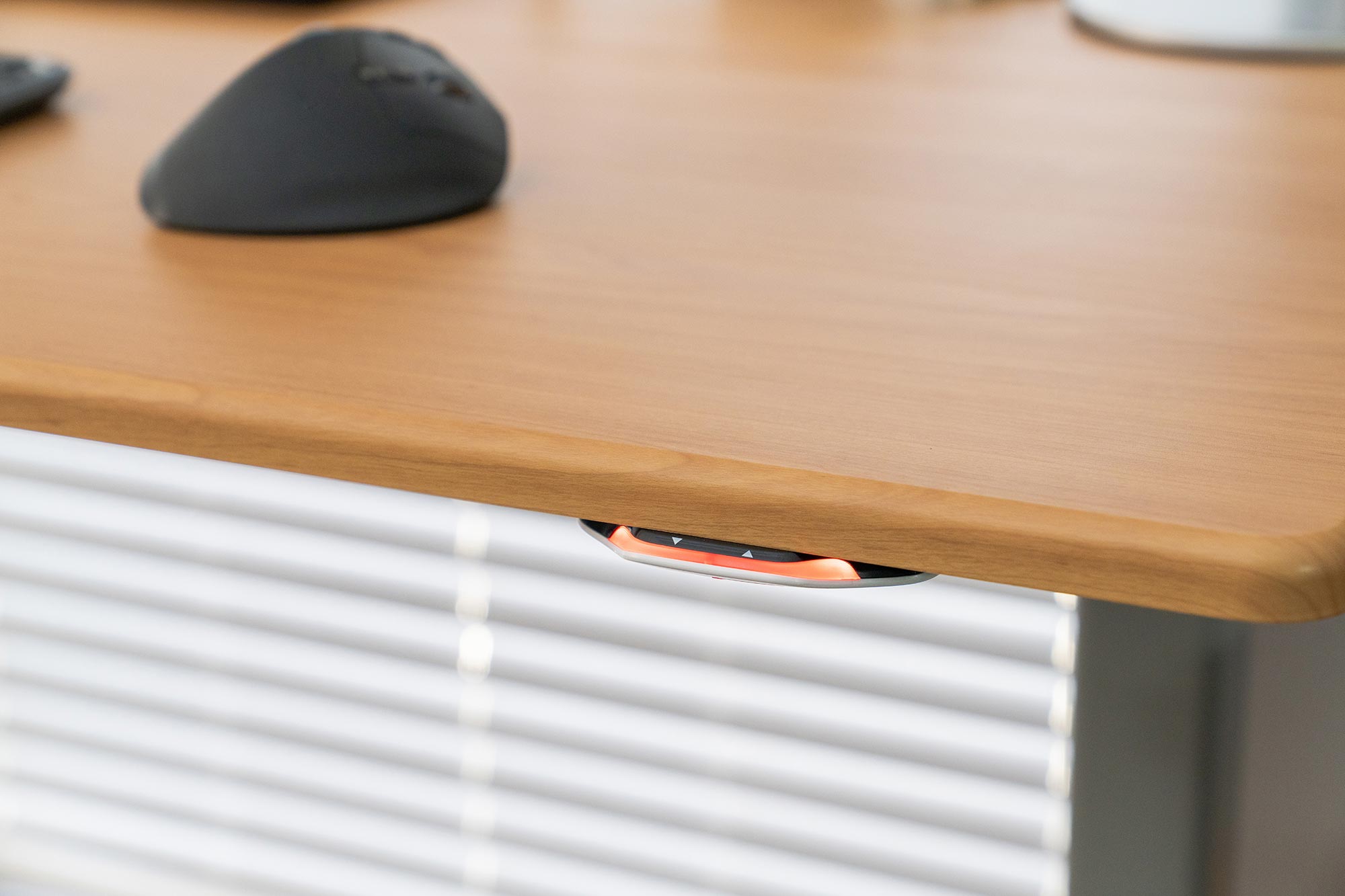Ergonomics
TABLE OF CONTENT
Ergonomics
The Importance of Being Ergonomic
Ergonomics comes from the Greek word ergos, meaning work. It’s defined as the study of people’s efficiency in their working environments. Here’s a simpler, more practical definition: ergonomics is about staying healthy and productive by working in a way that induces the least amount of strain on your body in the long term. This means that your workstation needs to be designed around you, not the other way around. It means working from a neutral position— instead of how we contort ourselves to fit our keyboards, mice, and desks. The old cliché “work smarter, not harder” sums it up nicely.
The problem with the state of modern ergonomics is that there is an antiquated focus on sitting. The field of ergonomics has its roots in an era when employers were looking to optimize environments for workers sitting at typewriters. The word “ergonomics” did not enter the English dictionary until the 1950s, a time period when carpal tunnel syndrome made its unwelcome self known to the world. And while fighting carpal tunnel syndrome is all well and good, the battle does not end there. Part of the problem is that, neck, shoulder, and back pain are just as dangerous. But the issue that’s becoming a huge problem today is this: old-school ergonomics just aren’t suited for standing and treadmill desks.
iMovR is dedicated to researching the emerging field of active workstation ergonomics. It’s still the case and has been for a while that old school ergonomists preach outdated sitting desk ergonomic techniques for standing applications. This is a failure in the education system to keep up with changing times. With no research out on the market, we had to conduct our own. We researched what it takes to make an ergonomic standing desk workstation: the new demands, the alternative positions, and the stresses of moving, and came out with a pool of data from which we could actually design products. With that information in hand (which we continue to research to this day,) we’ve been able to make the products that you see on our site: state-of-the-art ergonomic, high-quality active workstations that you can count on to keep yourself healthy and productive at work.
Why should your company care?
It’s a no-brainer that an individual should be interested in proper ergonomics: you want to stay healthy, you want to avoid pain, and getting more work done isn’t bad either. But what if you’re a company that has to decide how to spend your wellness budget? Setting up ergonomic workstations in bulk sounds daunting, but in the long run will always win out over menial discounted gym memberships.
Ergonomics leads to both productivity and reduced healthcare costs in the long run. Neck, shoulder/back, and of course wrist pain can all be held at bay, if not prevented entirely, by a properly configured ergonomic workstation. It doesn’t matter whether your employees are getting their daily 10,000 steps or 30 minutes of strenuous exercise. As awesome as those things are for general health, what matters is workstation efficiency and productivity. Ergonomics is a win for both individuals and companies looking toward the future.
What is anthropometry?
Anthropometry is the study of human physical measurements and proportions (from your standard height and weight, to your neck-to-arm-length ratio) across both individual and larger, global scales. Anthropometry determines why your clothes are available in the variety of sizes that they are. In relation to active workstations, iMovR aims to create standing desks, treadmill desks, and converters that best serve the greatest percentage of the population, with products like height extenders and monitor arms that allow you to fully tailor your workstation to your body. Because no two humans are exactly the same, our products are designed to be configured to meet your needs. You can think of anthropometry as being the thing that designers use to create products that can be operated ergonomically by their users.
A Guide to Standing Desk Ergonomics
A Guide to Standing Desk Ergonomics
Let’s outline the ideal ergonomic configuration for your standing desk. Before we get started, we should note that you should not stand for eight hours a day, every day. You should switch between sitting, standing, and walking at one to two-hour intervals. This helps to simulate the environment your body was made for—our bodies were not really meant to do anything for eight hours straight other than sleep. Changing your work position promotes better blood flow and reduces the chance of pain in the long term.
Standing Desk Height and Wrist Alignment
The first thing you want to do is make sure that your desktop is at the correct height. The determining factor should be the position of your wrist and forearm while typing. You want to make sure that your wrists are at a neutral position, or as close to it as possible. This means that your wrists should be close to level with your forearms, and your elbows should be only slightly bent. iMovR’s Steadytype line of adjustable built-in keyboard trays makes ideal ergonomics achievable, as you can tilt your keyboard down, allowing you to easily keep your wrists straight. If you don't have a SteadyType keyboard, you'll have to bend your elbows more in order to keep your wrists straight.
It will take a bit of adjusting to find the ideal height for your standing desk. There’s no harm in making minor adjustments to your standing desk height either—just make sure your wrists are staying straight.
Monitor Ergonomics
The next piece of the puzzle is your monitor. For anyone over 5’2” or so, working while standing requires a monitor arm for proper ergonomics—otherwise, your monitor will not be high enough and you’ll end up straining your neck. The top of your monitor should be at about eye level, which means you can look straight ahead without bending your neck.
Additionally, you’ll want to be at about arm’s length from your monitor. This is mostly up to personal preference—the real goal is to minimize neck movement while working. For this reason, the ideal monitor size for most people is 20-24 inches. Dual monitors present a minor ergonomic challenge, as they necessitate head-turning to use. We recommend changing your “main” screen every so often so that your neck isn’t constantly turned in one direction.
Posture
Just as avoiding slouching is an essential part of sitting ergonomics, keeping “good” posture is key to standing ergonomics. Standing up straight helps to prevent back pain. You’ll find that as you stand, you naturally shift positions slightly, and that’s ok. The key parts of standing ergonomics are to keep your chest open and your shoulders back—don’t hunch over your desk for long periods of time. Additionally, you’ll want to keep your upper arms close to your body. If you have to extend your arms forward like you’re in a conga line, you’re too far from your keyboard.
Use a Standing Mat
A good standing mat is an essential part of your active workstation. iMovR’s line of EcoLast Premium standing mats are made from 100% polyurethane at 0.75” thickness, alleviating foot pain and allowing users to stand for longer periods of time. While it may seem superfluous, most users find that once they’ve worked with a good standing mat, it’s hard to go back to standing on plain carpet or hard flooring.
To Summarize:
- Keep your wrists straight
- Keep your arms at a neutral position
- The top of your monitor should be at eye level
- Your monitor should be approximately arm’s length away
- Your upper arms should be close to your body
- Stand up straight, with your chest open and shoulders back
A Note on Laptops
It’s worth noting that laptops are especially problematic with standing desks. Laptops were designed to be used while sitting—that’s the only way that the screen-attached-to-keyboard model makes any sense. We highly recommend outfitting your setup with both a peripheral keyboard and an external monitor with a monitor arm, like the iMovR Dual-Purpose Laptop Holder or Laptop Mount Tray. You don't want to look downwards all day and suffer neck pain, so the monitor arm is necessary for optimal placement.
If you intend to use your laptop screen in addition to the monitor, we recommend using a notebook adapter and a second monitor arm, allowing you to position your laptop above your desk, in conjunction with a peripheral keyboard. If you only need one monitor, you can use your laptop keyboard, making sure to set your desk at the right height without having to worry about looking down at the screen. The only problem with using your laptop keyboard is that you sacrifice the ergonomics of "split" keyboards, which offer a host of benefits.
A Guide to Treadmill Desk Ergonomics
A Guide to Treadmill Desk Ergonomics
Treadmill desking presents a unique set of ergonomic challenges—your body in motion behaves differently than your body at rest. That being said, a lot of what we said about standing desks also applies to treadmill desks. Before we move on to what’s different, let’s review ergonomic practices that carry over to treadmill desking from general standing desk use:
- You still want to have your monitor approximately arm’s length away, with the top of the monitor at eye level. (One additional thing to consider for treadmill desking is the issue of multiple monitors—turning your head from side to side while walking could lead to neck pain, so sticking to one monitor may be ideal.)
- The next position is still your best position—remember to switch between sitting, standing and walking at regular intervals (1-2 hours) throughout the work day.
- Your wrists should still be at a neutral position while typing.
Typing While Walking
One large difference at a treadmill desk is that you’ll naturally tend to use your hands to anchor yourself to your desk as you move. This is natural, and it further emphasizes the need for a SteadyType keyboard. Holding on to a peripheral keyboard tray will while walking will not feel stable, and foregoing a keyboard tray will lead to improperly aligned wrists. For treadmill desking, we highly recommend using a SteadyType keyboard and setting its angular incline to around 40 degrees as a starting point and adjusting to a comfortable position from there.
You may also want to consider an ergonomic keyboard and mouse. Keyboards that are split in the middle allow for more natural hand positioning. Instead of a mouse, you may want to try a trackball, which could be easier to manipulate while walking. When you’re trying out a new set-up, be sure to spend a few days with it before deciding whether or not you like it—even proper ergonomics may feel off at first if you’ve been doing it wrong your whole life!
Desktop Height / Width
When planning your space, you’ll want to make sure that you are using a large enough desk. This means 20” on the left and right sides of the treadmill, as well as 40” behind the treadmill. If your desk is large enough, you can put your treadmill on one side and your chair on another, creating a sit-stand-walk workstation. If not, we recommend using one of our Treadtop Chairs for sitting breaks. As the name implies, it can go right on top of the treadmill when you’re not walking, which is perfect for those with tighter spaces.
As for height, the same principles as any standing desk apply, with an added 4” of height for the treadmill. iMovR offers desk height extenders for tall users, providing proper ergonomics for people up to 6'5"
Stretching
Stretching can help to keep you healthy and comfortable throughout the day no matter how you work, but at a treadmill desk, stretching can be a real game-changer. We recommend focusing on your legs, hips, neck, and back. Keep it fun by getting some of your coworkers to join you in a daily routine!
(Hips) Inner Hip Flexor Stretch
1. Stand in a split stance, squeeze butt muscles and shift body forward, straightening rear leg.
2. Raise arm - same side as rear leg - to opposite side until stretch is felt in front of pelvis.
3. Hold and rotate back; hold 30 seconds.
(Glute) Seated Piriformis Stretch
1. Sit in a sturdy chair. Place the ankle of the leg you want to stretch over the opposite knee in a "figure 4" position.
2. Lean forward until you feel a stretch in your butt.
3. Hold the stretch from 30 seconds to 2 minutes depending on your comfort level.
(Calves) Soleus Stretch
1. Stand with feet straight in staggered stance rear leg extended.
2. Bend rear knee and slowly lean back with the upper body until the stretch is felt in the back of lower leg.
3. Hold 30 seconds.
Treadmill Set-Up
Make sure that your treadmill (and desktop, for that matter) are on firm, even flooring. You can adjust the “feet” of your treadmill to make sure it’s perfectly level. This will reduce torquing forces on the frame, which can cause the belt to move out of position, leading to irritating noises and potentially a reduced life expectancy for certain components.
How to Optimize Space With iMovR Products
Decorating a new office with limited space? We build our desks to fit various types of spaces from classic restricted cubicles to counters to open workspaces. Accommodate both the workers’ needs and a modern aesthetic in a small office with the following products and ideas.
iMovR Corner Desks
Corner desks are notoriously bulky and often look outdated. Adjustable height corner desks, however, are sleek in design and construction. iMovR’s corner desks make perfect building blocks for collaborative layouts and space-saving configurations. Featuring a chamfered edge, they can be placed against walls, allowing for monitor arm installation. An arrangement of four Jaxson Corner Standing Desks can accommodate under desk treadmills without reducing the real estate imprint.
Compact Desks
A compact desk is a great solution for a cubicle. A smaller worksurface translates into reduced real estate imprint, which results in better space management and long-term savings. This is a good solution for offices that don’t rely too much on paperwork. A monitor arm, a keyboard tray, and a laptop stand can additionally free up the working surface area, leaving more room for writing, document signing, and storage.
The Jaxson Compact Standing Desk comes with a 24" deep tabletop. Its small size doesn’t take away from its American-made quality, tech-forward features like Bluetooth and NFC, and advanced brushless motor lifting columns.
Desk Converters
While compact standing desks are great for saving space, sit-stand converters are also mobile. You can place them on any surface, not just the old traditional sitting desk. A smaller work surface may be a problem for those working with paper documents, but there’s enough room for a separate monitor, mouse, and keyboard.
ZipLift+ is our most popular converter model with a working surface of 35.4" and a tilting keyboard tray. With a weight capacity of 35 lbs., this desk converter is the best in its category for modern workspaces that involve hot-desking, shared workspaces, and small offices.
Storage Ideas
Another way to save space in a small office is through smart storage. Since most standing desks feature no drawers or shelves, you can use multipurpose furniture to maximize your storage space.
Cubby wall storage as a divider
A cubby wall storage that doubles as a divider can help you divide open workspaces all while adding storage space to the office.
Mobile file cabinet as a seat
iMovR 3D-laminated and solid wood mobile file cabinets come in matching colors and can not only store documents but doubles as a seat.
A storage wall doubling as a whiteboard
Whiteboards and writing surfaces are very popular in modern office design, but you can make the most of them if you use them in a tandem with storage walls.
Creating Better Collaborative Active Workspaces With iMovR
1. Centers for Disease Control and Prevention. (n.d.). Physical Activity and Health. Retrieved October 20, 2017, from https://www.cdc.gov/physicalactivity/basics/pa-health/index.htm
2. Ben-Ner, Avner, et al. “Treadmill Workstations: The Effects of Walking While Working on Physical Activity and Work Performance.” PLoS ONE, Public Library of Science, 20 Feb. 2014, www.ncbi.nlm.nih.gov/pmc/articles/PMC3930588/
3. Levine, J. A., Weg, M. W. V., Hill, J. O., & Klesges, R. C. (2006). Non-Exercise Activity Thermogenesis: The Crouching Tiger Hidden Dragon of Societal Weight Gain. Arteriosclerosis, Thrombosis, and Vascular Biology, 26(4), 729–736. https://doi.org/10.1161/01.ATV.0000205848.83210.73
4. Carpal tunnel syndrome. (n.d.). Retrieved November 29, 2017, from https://www.umm.edu/health/medical/reports/articles/carpal-tunnel-syndrome
5. Dr. Jerome Congleton. (2013). Standing Mat Study Report- Texas A&M University. Texas A&M University. Retrieved from http://www.workwhilewalking.com/wp-content/uploads/2015/01/Standing-Mat-Study-Texas-AM-University-2013.pdf
6. eTools | Computer Workstations eTool | Occupational Safety and Health Administration. (n.d.). Retrieved November 29, 2017, from https://www.osha.gov/SLTC/etools/computerworkstations/
7. Buckley JP, Hedge A, Yates T, et al. Br J Sports Med Published Online First: [26 March 2015] doi:10.1136/ bjsports-2015-094618 https://www.getbritainstanding.org/lara_base/public/pdfs/gbs/expert_statement.pdf
Download the complete guide
(We're putting on the finishing touches, and we'll email you as soon as it's published...)






